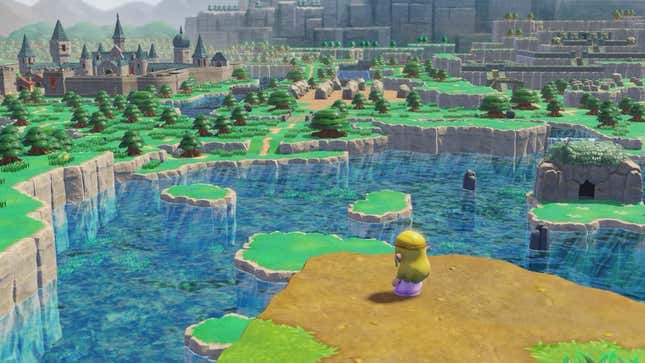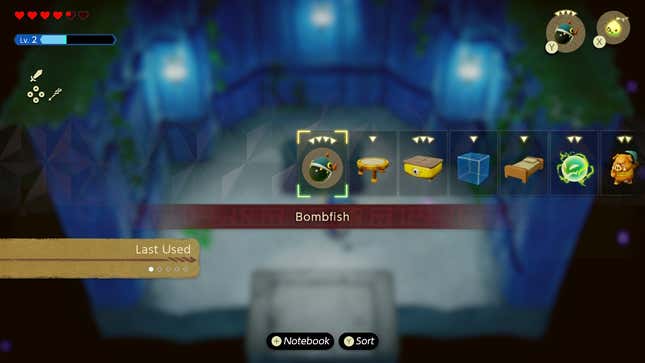How do you follow up on some of the most critically acclaimed games of the last decade? Many thought Nintendo couldn’t top the sheer open-world wonder and creativity of the physics toybox that The Legend of Zelda: Breath of the Wild – a revelation. However, Nintendo seemed to do just that with Tears of the Kingdomwhich offers players a variety of new ways to interact with the world and expands the already vast realm of Hyrule both into the skies and the depths below, representing such a vast improvement over its extraordinary predecessor that it arguably makes it obsolete.
Between these two games we also got Left Awakening, a 2019 remake of a classic Game Boy adventure, replacing the pixel art of the original with toy-like and dioramic graphics to recreate the retro feel for the modern age. The Legend of Zelda: Echoes of Wisdom takes that same charming artistic direction and applies it to a completely original story featuring our beloved Hyrule Princess Zelda. It also tries to combine the player-driven creativity and problem-solving from both Breath of the Wild And Tears of the Kingdom with classic top-down Zelda Gameplay, and it works! Mostly.
Echoes of WisdomIn the story, Hyrule is threatened by dark rifts that are engulfing the land and trapping its inhabitants, including our usual hero Link in the green tunic, in a frozen space-time continuum. Zelda and her fairy companion Tri set out to resolve these rifts and free the prisoners. With Link himself trapped in one of these rifts, it falls to Zelda to save the land herself – for the first time in a main game in the series.

The main difference between playing as Zelda and stepping into Link’s shoes is that she doesn’t fight her enemies directly with the usual sword and shield, at least not most of the time. Using Tris’ magic, Zelda can create “echoes,” which are clones of objects and monsters she’s encountered in Hyrule. She can summon things like beds, tables, and chairs, but also creatures like blobs that create electrical force fields, and spear-wielding goblins (or moblins, as they’re called in Hyrule). Here comes Echoes of WisdomThis is where free creativity comes into play.
When traversing the game’s dungeons and puzzles, my strategy was always to stack beds on top of each other, creating a makeshift bridge to span wide gaps. It was similar to a strategy I used in Tears of the Kingdom, where I simply glued logs together to make a bridge. While this often helped me in the early game, in later dungeons I had to think more creatively. For example, when the gaps were too big for my bed bridge, I stood on the edge of my unfinished creation and also used an echo that, when picked up, blew a stream of wind in the opposite direction from Zelda, propelling her far enough to reach the other side. When your solutions actually end up working, it’s a huge sense of achievement, and Echoes of Wisdom provides these feelings in abundance and gives you a feeling of satisfaction and confidence throughout.
When Echoes begins, Tri’s magic is limited, so there’s a cap on how many Echoes you can summon at once. But the game’s progression system feels natural; as Tri becomes more skilled, she and Zelda clear more rifts throughout the story, and the cap increases, allowing Zelda to summon more Echoes at once.
Echoes of Wisdom feels a bit like a puzzle game and is reminiscent of the older parts of the series, which had complicated dungeons that you not only had to fight through, but also solve. In this game, you get through them with the help of the echoes, which act almost like the main progress-facilitating items you would have received in previous games.

To keep this classic alive Zelda Feeling, our intrepid heroine has limited access to Link’s iconic swordsman repertoire. For a limited time, she can enter a “swordsman mode” where she can swing a sword, shoot arrows, and throw bombs – all the things Link could do when he was the protagonist. At times, this felt like a concession to long-time Zelda players who just want to return to Link’s gameplay. In the context of Echoes of Wisdom‘s mechanics make it feel pretty overpowered, even if it’s only active until Zelda’s energy meter is depleted. Part of Zelda’s fighting style involves letting the Echoes do the dirty work for her, meaning you risk having your bomb-making fish Echo destroyed by an enemy before it can go off. Swordsman Mode essentially becomes a “press to win” button because Zelda can just spam bombs. Additionally, Zelda can continuously drink smoothies she can make from various ingredients throughout Hyrule to recharge her energy meter. This method effectively allows her to enter and stay in Swordsman Mode more often and for longer. Unfortunately, this results in the majority of Zelda’s Echo arsenal being trivialized, as Swordsman Mode makes short work of even bosses.
Combat is best when relying on Echoes, and finding new Echoes is half the fun of actually using them. Every time I defeated a new enemy, I was excited to scan them and create Echoes of them. It felt like I was playing Pokemonand try to collect as many as possible. However, this leads me to Echoes of WisdomThe most noticeable problem is echo management.
There are dozens and dozens of these Echoes, and it’s a real pain to go through the entire list of all Echoes while looking for the specific Echo you need for your particular situation. There are some helpful sorting tools, such as the ability to sort by most recently used or most recently acquired Echo, but I wish the game would let you sort your Echo collection manually.

Exploration also plays a major role in Echoes of WisdomThe map is very similar to that of A connection to the pastand feels like a sort of homage to the franchise’s past. The game is also surprisingly long—it’ll take you 25 to 30 hours to complete just the main story. It’s filled with dozens of side quests and optional dungeons. Some of these side quests are quick and easy, like finding and killing a monster that can summon rain and showing it to a local, or searching for missing chickens scattered around a town and bringing them back to a farm. Others, however, are quite involved, including a multi-step one that eventually rewards you with the powerful ability to build robots that can perform massive area of effect attacks. They’re a huge boon, especially during boss fights.
I felt like the rewards you get for completing side quests were much more valuable than in most RPGs. While you’ll probably just earn more rupees to spend in shops, you’ll also likely encounter a new Echo along the way that could come in handy later. In fact, some of the most useful Echoes are stashed away in optional dungeons, making exploration even more rewarding. Early on, I came across a giant plant that could catapult itself into monsters and deal constant damage with its limbs. It was an incredibly powerful Echo at that point in the game and allowed me to steamroll many of the early game bosses.
While exploring is fun and rewarding, I wish Zelda’s running speed was faster. She runs excruciatingly slowly and it’s incredibly frustrating. She has a small spinning move that doesn’t do any damage, but combined with running, it actually makes her much faster than her usual sprint. So I found myself constantly pressing the right bumper button while moving to break into an impromptu spinning sprint when running in the wild.
Echoes of Wisdom successfully combines the feeling of previous Zelda Games with the new creative direction that the modern entries have taken. By merging the classic key element progression of older Zelda games with the more modern, player-driven problem solving of Tears of the Kingdom And Breath of the Wild, Echoes of Wisdom creates something that is both familiar and different from any other game in the series. Plus, our long-suffering Hyrulian princess finally gets some time in the spotlight, and that’s a welcome change.
.
Table of Contents



